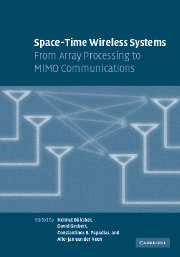Book contents
- Frontmatter
- Contents
- List of contributors
- Acknowledgments
- Introduction
- Part I Multiantenna basics
- Part II Space-time modulation and coding
- Part III Receiver algorithms and parameter estimation
- 12 Array signal processing
- 13 Optimal subspace techniques for DOA estimation
- 14 Blind and semiblind MIMO channel estimation
- 15 MIMO receive algorithms
- 16 Space-time turbo coding
- 17 Training for MIMO communications
- Part IV System-level issues of multiantenna systems
- Part V Implementations, measurements, prototypes, and standards
- Index
12 - Array signal processing
Published online by Cambridge University Press: 25 February 2010
- Frontmatter
- Contents
- List of contributors
- Acknowledgments
- Introduction
- Part I Multiantenna basics
- Part II Space-time modulation and coding
- Part III Receiver algorithms and parameter estimation
- 12 Array signal processing
- 13 Optimal subspace techniques for DOA estimation
- 14 Blind and semiblind MIMO channel estimation
- 15 MIMO receive algorithms
- 16 Space-time turbo coding
- 17 Training for MIMO communications
- Part IV System-level issues of multiantenna systems
- Part V Implementations, measurements, prototypes, and standards
- Index
Summary
In this chapter, an overview of the fundamentals of array signal processing is provided with a particular emphasis on recent advances in direction-ofarrival (DOA) estimation and adaptive beamforming. It is then highlighted that the signal models used in array processing and space-time block coded MIMO communications are rather similar. At the same time, the MIMO model enjoys some interesting properties that do not emerge in classical applications of array processing. Using the established links between the aforementioned models, several important applications of array processing philosophy and concepts to point-to-point and multiuser MIMO communications are discussed.
Introduction
Sensor array processing has a long and rich history of theoretical research and practical applications to radar (Brennan et al., 1976; Haykin, 1980; Haykin et al., 1992; Swindlehurst and Stoica, 1998); sonar (Cox, 1973; Morgan and Smith, 1990; Böhme, 1995; Gershman et al., 1995; Krolik, 1996); wireless communications (Winters, 1982; Godara, 1997; Paulraj and Papadias, 1998; Paulraj and Gesbert, 1998); navigation (Evans et al., 1982; Amin et al., 2004); seismology (Capon et al., 1967, 1969; Böhme, 1995; Sidorovitch and Gershman, 1998); biomedicine (Hochwald and Nehorai, 1987; Mosher and Leahy, 1998; Li et al., 1998); radio astronomy (Raza et al., 2002; Boonstra and van der Veen, 2003); and other fields (Spielman et al., 1990; Zoubir and Böhme, 1995; Nehorai et al., 1995; Gershman and Turchin, 1995; Liu et al., 1996; Nehorai and Jeremic, 2000).
- Type
- Chapter
- Information
- Space-Time Wireless SystemsFrom Array Processing to MIMO Communications, pp. 241 - 260Publisher: Cambridge University PressPrint publication year: 2006
- 2
- Cited by



